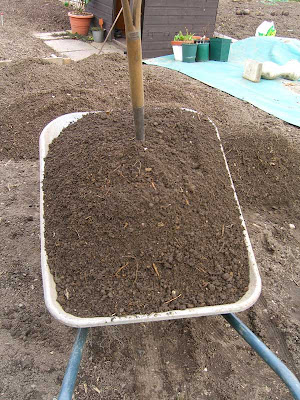 |
| Compost from the mega compost heap. |
I know that I keep on going on about it but this is really good compost from the mega compost heap. You can see the piles where I am putting it. I put about 6 barrowloads on this area of the leek bed. It probably does have a lot of weed seeds in it but that is a little problem compared with the nutrients, carbon and micro organisms that are added by compost like this. There were lots of millipedes (Oops I really mean centipedes because they are carnivores) in this barrow of compost. I am hoping that they will eat any pests around this area.
As I was digging out the compost, I found several wire ties. I have been buying wire for ties for years and now I have a big tub full of them. I doubt very much if I will have to buy wire this year. One saving at least.
An aim of mine, if you could say I had aims on the allotment, is to garden with as little cost as I possibly can and that is why I don't like watching gardening programmes on television. They always tell you to buy the most expensive gardening things and never seem to suggest that there is any other way of gardening.
Now you might think that I have passed this compost through a sieve to get it as fine as this. I have sieved the compost because it had a lot of couch grass and bind weed rhizomes in it. However, every time I use a sieve I get tendinitis in my shoulder. So I hatched a cunning plan. Buried deep inside the mega compost heap was an old bakers tray like this one:
http://www.alisonhandling.com/plastic_boxes/210_210/tn_cds15.jpeg
I leant the tray up against the cliff face of the compost heap and ran the compost down it. The good stuff falls through the holes while the rough stuff is retained in the tray. It filters really well as you can see in the photograph above. I was going to take a photograph of the mega compost heap today but I found that I had forgotten to put the memory card back into the camera. That meant that the camera would only take one picture and then said that its memory was full.
I am going to fork the compost into the top 6 inches of soil so that the plants can take full advantage of it straight away. I did the same with the ground under the taupalin. I will keep the tarpalin on the ground until I have space to store it in the store shed.
I can still reach the parsnip clamp just by lifting a corner of the taupalin. There may be a good arguement for sowing parsnip seeds, although I will need to take the soil temperature. I didn't remember to take the soil temperature even though I looked at the thermometer several times and said to myself you need to take the soil temperature.
You can also see the cuttings I took last year of the blackcurrants and the gooseberriesn in the green pots. I am not too sure where I am going plant the blackcurrants but the gooseberries have a dedicated area next to the comfrey bed.
I started to put the canes up for the sweetpeas. It then began to rain...
I spent a little time putting the tools away and locking the sheds. Then I went down to the black bins covering the rhubarb. It would seem that I am successfully forcing some of the stems. This supposed to make the stems sweeter however I think that it just reduces the amount of oxalic acid in them and makes them more digestable. Most people would tell you that the oxalic acid in rhubarb is confined to the leaves, yet a lesser amount is also found in the stems too. You would have to eat an awful lot of rhubarb leaves to kill yourself and the little you will find in rhubarb stems could never harm you.
Needless to say, I spent too long down at the allotment and got no sowing in the greenhouse done. I did put the Oca in the greenhouse with the potatoes. The Oca had started to sprout making me optimistic about whether they will grow in my allotment or not.
There is always tomorrow and I am always in a rush to start planting things. If Scotland is to be considered, winter is certainly not over yet.























